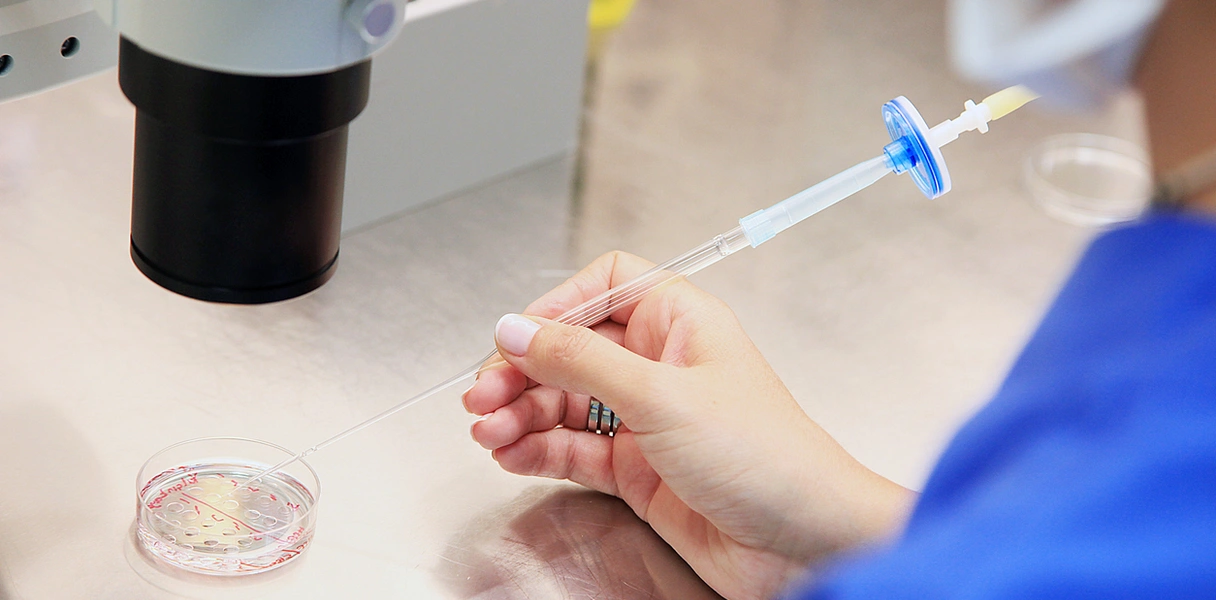The main advanced techniques are: PICSI, which selects mature sperm capable of binding to hyaluronan; MFSS, which uses microfluids to mimic natural selection; and MACS, which removes damaged sperm through a magnetic system. Each one is applied according to the needs of the couple or patient.
Sperm selection
Advanced techniques to optimize sperm quality

PICSI (physiological intracytoplasmic sperm injection)
PICSI is a variation of the ICSI method that uses exclusively mature sperm, specifically selected for their ability to bind to a hyaluronan gel.
Hyaluronan is a substance that surrounds the egg and is involved in the natural binding between egg and sperm. Only mature sperm —with a lower incidence of chromosomal abnormalities— adhere to this gel, which improves the quality of the sperm used for fertilisation.
MFSS (microfluidic sperm selection)
In this method, sperm are placed in a disposable chip, where they actively migrate through microbarriers and a membrane into outlet chambers. This process selects and collects the most viable and healthiest sperm, simulating the natural selection that occurs in the female reproductive tract.
The technique allows the selection of sperm with:
- Better motility
- Greater genetic integrity
- Optimal morphology
It also significantly reduces the proportion of sperm with fragmented DNA and, in some cases, increases by up to 35% the proportion of euploid embryos (with normal chromosomal load) and the overall treatment success rate.
It is recommended in cases of:
- Low fertilisation rate with ICSI in previous cycles
- Repeated failures of intrauterine insemination (IUI)
- Multiple embryo transfers without implantation
- Poor embryo quality in previous IVF cycles
- Other specific medical indications
MACS (magnetic-activated cell sorting)
In this method, sperm that are marked to die (sperm with programmed cell damage) display a specific marker on their membrane. During the MACS process, metallic particles bind to these markers and a magnet selectively removes the marked sperm.
The result is a sample enriched with high-quality sperm, especially those with intact DNA, ideal for fertilising eggs.
MACS es especialmente útil en los siguientes casos:
MACS is particularly useful in the following cases:
- High sperm DNA fragmentation
- Arrested embryo development in previous cycles
- Recurrent miscarriages
- Implantation failure after several transfers
- Women of advanced maternal age
Preguntas frecuentes sobre selección de espermatozoides
What is sperm selection and why is it important?
Sperm selection is a process that makes it possible to choose the healthiest and most viable sperm to fertilise an egg. Its importance lies in improving the quality of the embryos obtained and, therefore, increasing the chances of success in fertility treatments.
What sperm selection techniques are available?
In which cases are these techniques recommended?
They are usually recommended in cases of poor embryo quality, repeated fertilisation or implantation failures, recurrent miscarriages, high sperm DNA fragmentation, or when previous treatments have not been successful.mientos previos no han tenido éxito.
Does sperm selection increase success rates?
Yes. These techniques help select sperm with better morphology, motility, and genetic integrity, which leads to higher embryo quality and, according to some studies, a significant increase in implantation and pregnancy rates.
Does sperm selection replace ICSI or IVF?
No. These are complementary techniques to in vitro fertilisation (IVF) or ICSI. Their aim is to improve the quality of the sperm sample to be used in the procedure, thereby increasing the chances of success.
How is the most appropriate technique chosen for each patient?
The decision depends on medical history, the results of previous treatments, and fertility tests. The medical team assesses each case individually and recommends the technique that best suits the needs of the couple or patient.
What is the difference between PICSI, MFSS and MACS?
- PICSI: selects mature sperm through hyaluronan.
- MFSS: simulates the natural journey in the female tract and selects sperm with better motility and intact DNA.
- MACS: removes damaged or apoptotic sperm, leaving only the most viable ones.
Is sperm selection painful?
No. These techniques are performed directly on the semen sample in the laboratory, without the patient feeling any pain or needing invasive procedures.
Do these sperm selection techniques have an additional cost?
Yes, they usually involve an extra cost within the assisted reproduction treatment, as they require specific materials and advanced technology. The price depends on the technique used and on each clinic.